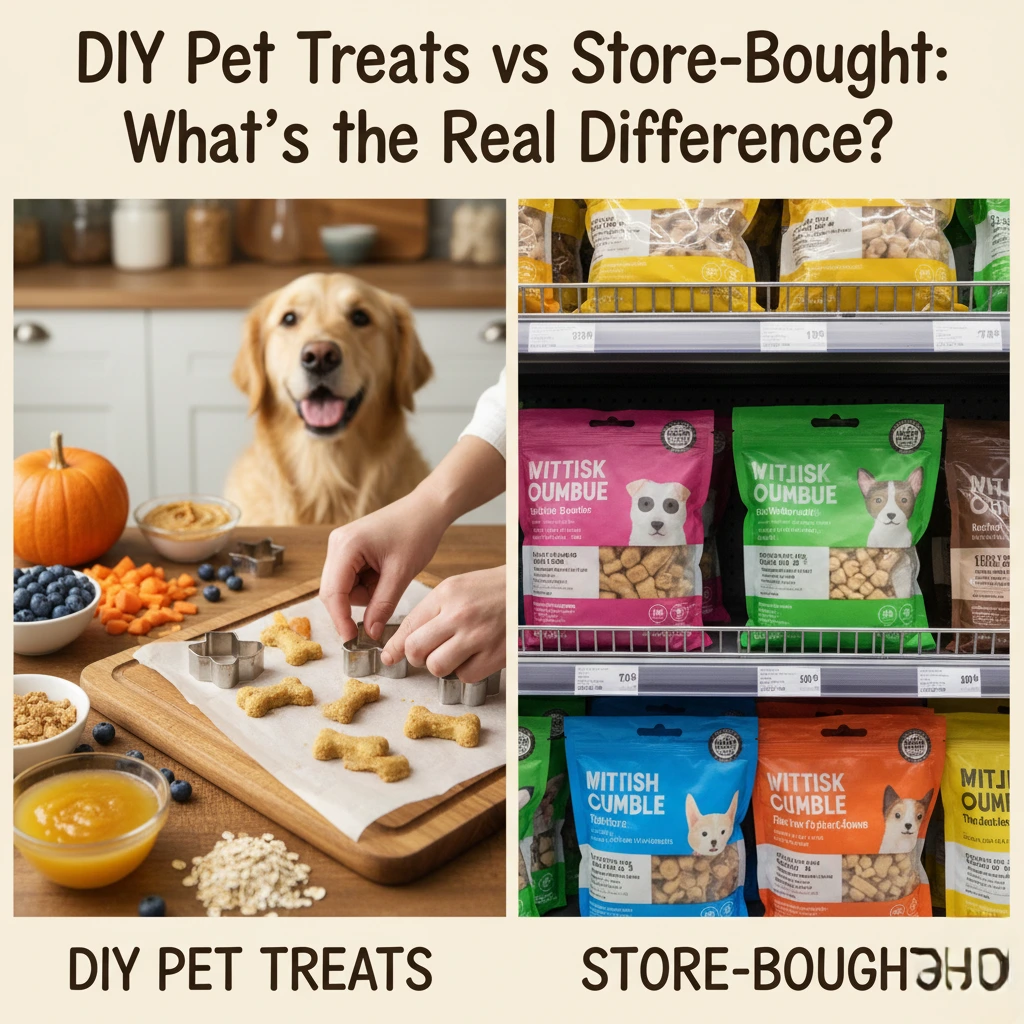If you’re a pet parent, chances are you’ve stood in the pet food aisle wondering whether those brightly packaged treats are really as healthy as they claim to be. At the same time, you’ve probably seen countless social media videos of people baking homemade dog biscuits or whipping up cat treats from their own kitchens. The question remains: Are DIY pet treats actually better than store-bought ones? And what’s the real difference between the two when it comes to your pet’s health, safety, and happiness?
In 2025, the pet industry is booming, with a growing focus on natural, organic, and transparent pet nutrition. As more owners treat their pets like family members, understanding what goes into their snacks has become just as important as what’s in our own food.
The Rise of Conscious Pet Nutrition
Over the past few years, pet owners have become increasingly aware of the connection between diet and wellness. From grain-free formulas to organic kibble and limited-ingredient diets, the trend toward clean-label pet products has reshaped the market. This shift is fueled by a simple but powerful question: What are we really feeding our pets?
While commercial treats offer convenience, many pet owners are concerned about artificial preservatives, added sugars, and fillers. That concern has led to a new wave of DIY pet treat enthusiasts who prefer to take control of ingredients and nutrition at home.
What Are DIY Pet Treats?
DIY pet treats are homemade snacks crafted using simple, pet-safe ingredients. These can range from baked biscuits made with peanut butter and oats to frozen treats with yogurt and fruit. Many recipes are designed to mimic store-bought options but without unnecessary additives.
Pet owners who make their own treats love the transparency and creativity that comes with the process. They can customize recipes to their pet’s specific needs—like gluten-free for sensitive stomachs or low-fat for older pets. Plus, homemade treats often cost less in the long run and allow owners to reduce packaging waste.
What’s Inside Store-Bought Pet Treats
Store-bought pet treats vary widely in quality. While some are made by reputable brands that focus on wholesome, sustainably sourced ingredients, others may rely heavily on fillers, artificial colors, and chemical preservatives to extend shelf life.
The key ingredients in many mass-market treats include by-products, flavor enhancers, and stabilizers that make them look appealing and last longer. Although these additives are generally considered safe, they don’t always provide nutritional value.
That said, the pet food industry has evolved significantly. Many premium brands now produce natural and organic treats free from artificial additives. Some even include functional ingredients like omega-3s, probiotics, or CBD oil for health benefits. So, while not all store-bought treats are bad, it’s essential to read labels carefully and choose trusted brands with transparent sourcing.
DIY vs Store-Bought: Nutritional Differences
1. Ingredient Control and Quality
One of the biggest advantages of DIY treats is ingredient control. You decide exactly what goes into your pet’s snacks—no hidden preservatives or mystery “meat meals.” Using fresh ingredients like pumpkin, carrots, oats, or chicken ensures your pet gets real nutrition rather than empty calories.
However, store-bought treats have one advantage: nutritional consistency. Brands that follow strict quality control standards and work with pet nutritionists ensure their treats are balanced for specific dietary needs. If you’re not familiar with pet-safe ingredients, homemade recipes can accidentally become unbalanced or even harmful if certain foods—like onions, chocolate, or grapes—are used.
2. Shelf Life and Safety
Store-bought treats often last for months due to preservatives and controlled packaging. That makes them convenient for busy pet parents who can’t bake weekly. On the other hand, DIY treats have a shorter shelf life—usually a few days to a week, depending on storage.
Safety is also a concern. If homemade treats aren’t baked properly or stored in airtight containers, they can spoil or grow bacteria. Store-bought treats, when produced by trusted brands, are tested for pathogens and quality assurance, offering peace of mind.
3. Customization and Dietary Needs
Every pet is different. DIY treats give you the flexibility to tailor recipes for allergies, sensitivities, or health goals. For instance, you can create low-calorie snacks for weight management or include anti-inflammatory ingredients like turmeric for joint health.
Commercial brands are catching up with this trend. Many now offer functional treats—like dental chews, hip and joint bites, or skin and coat boosters—making it easier to target specific health needs with scientifically formulated options.
The Convenience Factor
Let’s be honest: time matters. Baking pet treats takes effort—from sourcing ingredients to mixing, baking, and storing. Store-bought treats win hands down in terms of convenience and portability. They’re perfect for training sessions, travel, or when you’re short on time.
However, for pet parents who love bonding moments, making treats at home can be rewarding. It’s an activity that strengthens the human-pet connection and adds a personal touch to your care routine.
The Cost Comparison
At first glance, DIY pet treats may seem cheaper, especially if you already have basic ingredients at home. But depending on the recipe, costs can add up—especially for organic or specialty ingredients.
Store-bought treats vary in price too. Mass-produced options are inexpensive, while premium brands can be costly. The best approach is to balance both: use DIY treats for special occasions and rely on store-bought for daily rewards or training.
Environmental Impact: Sustainability Matters
Sustainability is another factor driving the DIY trend. Making treats at home reduces packaging waste and carbon emissions linked to mass production and shipping. Pet owners committed to eco-friendly living appreciate this aspect.
Still, some eco-conscious pet food brands are improving sustainability by using recyclable packaging, responsibly sourced proteins, and upcycled ingredients. Supporting such brands can also align with green living goals.
Taste Test: What Do Pets Prefer?
Ultimately, your pet’s palate decides. Many animals love homemade treats because they’re fresher, softer, and made with familiar smells from the kitchen. Store-bought treats, however, often contain flavor enhancers and textures that make them irresistible.
If your pet has picky eating habits, experimenting with both DIY and store-bought options can help you discover what they truly enjoy.
Finding the Right Balance
The truth is, there’s no one-size-fits-all answer. The “best” option depends on your pet’s health, your schedule, and your comfort level with food preparation.
When to Choose DIY Pet Treats
- If your pet has food allergies or sensitivities
- If you prefer natural, additive-free snacks
- If you enjoy baking and experimenting with recipes
When Store-Bought Makes Sense
- When you need long shelf life and portability
- When using scientifically formulated treats for specific health needs
- When convenience is your top priority
Many pet parents find a happy middle ground: offering homemade treats occasionally while keeping high-quality store-bought snacks on hand for training and travel.
Conclusion
Whether you go the DIY route or stick with store-bought, what matters most is knowing what’s in your pet’s food. Both options have their strengths—homemade treats give you control and creativity, while commercial options offer consistency and safety.
The key is balance, awareness, and quality. Read ingredient labels, avoid harmful additives, and prioritize whole, natural ingredients. When you understand what’s fueling your furry friend, you’re not just feeding them—you’re caring for their overall well-being.
At the end of the day, every treat—homemade or not—should be a reflection of the love and attention you give your pet. That’s the real difference.



